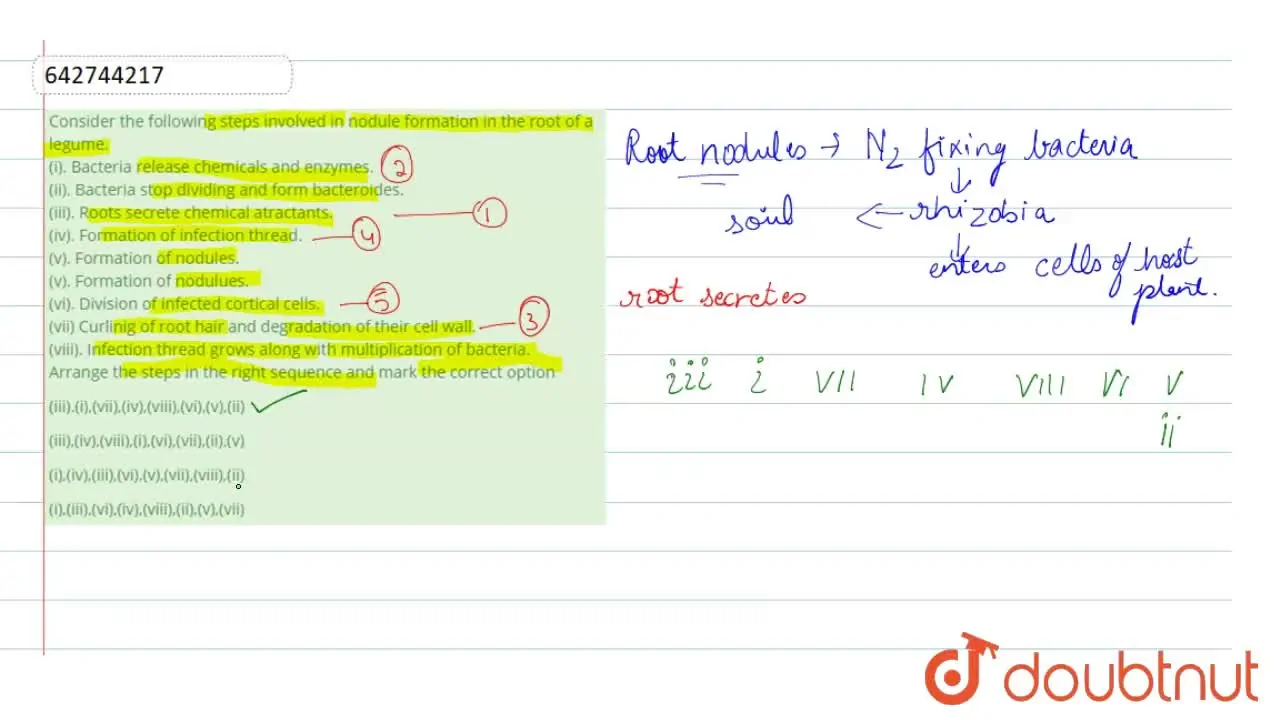Consider the following steps involved in nodule formation in the root of a legume.
(i). Bacteria release chemicals and enzymes.
(ii). Bacteria stop dividing and form bacteroides.
(iii). Roots secrete chemical atractants.
(iv). Formation of infection thread.
(v). Formation of nodules.
(v). Formation of nodulues.
(vi). Division of infected cortical cells.
(vii) Curlinig of root hair and degradation of their cell wall.
(viii). Infection thread grows along with multiplication of bacteria.
Arrange the steps in the right sequence and mark the correct option
(iii).(i),(vii),(iv),(viii),(vi),(v),(ii)
(iii),(iv),(viii),(i),(vi),(vii),(ii),(v)
(i),(iv),(iii),(vi),(v),(vii),(viii),(ii)
(i),(iii),(vi),(iv),(viii),(ii),(v),(vii)
The correct Answer is:A
Roots of a legume secrete chemical attractants. Bacteria collect over the root hair, release certain hormones and enzymes, which cause curling of root hair around bacteria degradation of cell wall and formation of an infection thread enclosing the bacteria. infection thread grows along with multiplication of bacteria. the inifected cortical cells of root divide and make direct connection with vascular tissues. it produces swellings called nodules. Infected cells enlarge. Bacteria stop dividing and form irregular polyhedral strutures called bacteroides.
Related Playlists
- BOOK - NCERT FINGERTPS ENGLISHCHAPTER - MINERAL NUTRITIONEXERCISE - Assertion & Reason15videos
MINERAL NUTRITION
- BOOK - NCERT FINGERTPS ENGLISHCHAPTER - MINERAL NUTRITIONEXERCISE - Mineral Nutrition130videos
MINERAL NUTRITION
- BOOK - NCERT FINGERTPS ENGLISHCHAPTER - LOCOMOTION AND MOVEMENTEXERCISE - Locomotion And Movement139videos
LOCOMOTION AND MOVEMENT
- BOOK - NCERT FINGERTPS ENGLISHCHAPTER - MORPHOLOGY OF FLOWERING PLANTSEXERCISE - Morphology Of Flowering Plants135videos
MORPHOLOGY OF FLOWERING PLANTS
Similar Questions
What are the steps involved in formation of a root nodule?
View SolutionWhat are the steps involved in formation of a root nodule?
View SolutionDuring root nodule formation in legumes:
View SolutionThe microbe associated with root nodule formation is
View SolutionWhich of the following cell organelles is involved in the formation of cell plate
View SolutionWhich of the following hormones is used in root formation on stem cutting?
View SolutionWhich of the following hormones is used in root formation on stem cutting?
View SolutionInfection thread during nodule formation in legumer is made up of:
View SolutionIdentify the role of lectins in formation of root nodules in legumes.
View SolutionThe function of leghaemoglobin in the root nodules of legumes is
View Solution


